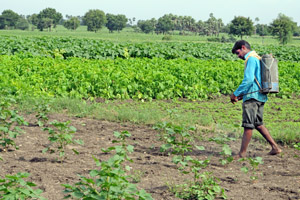Crop yields from India’s first genetically modified crop may have been overemphasized, as modest rises in crop yields may come at the expense of sustainable farm management, says a new study by a Washington University in St. Louis anthropologist.
The study, by Glenn Stone, PhD, professor of anthropology in Arts & Sciences, appears in the March issue of the journal World Development.
In his paper, Stone compares village yields in 2003 and 2007, which conveniently had very similar levels of rainfall. “Cotton yields rose 18 percent with the adoption of genetically modified seeds,” Stone says. “This is less than what has been reported in some economics studies, but much better than activists have claimed.”
Pesticide sprayings also were down by 55 percent with the switch to genetically modified seed.
The crop in question is Bt cotton, genetically modified to produce its own insecticide. Approved for Indian farmers since 2002, the technology is being closely watched because it is the most widely planted GM crop on small farms in the developing world.
Many activists and commentators, including England’s Prince Charles, have accused Bt cotton of failing, ruining small farmers and causing suicides, Stone claims.
Several studies by economists, however, have shown Bt cotton farmers to be getting higher yields when compared with planters of conventional cotton.
“These economics studies have had a serious weakness,” says Stone, the incoming president of the Anthropology & Environment section of the American Anthropological Association. “The adopters of the new seeds tend to be the most prosperous and well-financed farmers, who were getting better yields than other farmers even before Bt seeds were adopted. Our anthropological research project used a different strategy to assess the seeds’ performance.”
Stone conducted long-term research in four villages in Andhra Pradesh, India. He found that in 2003, none of the village farmers had adopted Bt seeds, but by 2007, adoption was 100 percent.

Glenn Stone
A cotton farmer in Warangal District, Andhra Pradesh, sprays pesticides on his Bt cotton. While overall pesticide use has been cut in half with the adoption of Bt seeds, spraying for pests not affected by Bt, such as aphids, is rising.
In the paper, Stone also examines overall farm management, finding that the new seeds have come with their own set of problems.
“I would love to see Bt seeds as a real solution to these farmers’ insect problems, as many have claimed, but this may be a bit naive,” Stone says. “Conditions in the cotton fields change quickly. Populations of insects not affected by Bt have now begun to explode. We can’t forget that cotton farmers enthusiastically adopted pesticide sprays in the 1990s, only to watch them quickly lose their effectiveness.”
Stone shows that the farmers’ real problem was never just with cotton pests.
“Before Bt seeds appeared, these farmers had to contend with seed and spray brands and technologies that changed so quickly that the process of judicious experimentation and adoption had broken down,” he says.
The technology in genetically modified seeds is already starting to change at an even faster pace than conventional seeds and pesticides.
“Looking beyond the field level to the farm level you see the real problem was a set of factors that eroded the normal process of farmer evaluation of technologies — there were too many rapid, undecipherable changes,” Stone says. “Each new technology — hybrids, then pesticide after pesticide — brought short-term gains but further eroded farm management. Bt cotton has raised yields on average, but already we are seeing erosion of benefits as non-target pest populations are booming. It has also brought a quickening of technological change and undecipherability, which is the real underlying problem.”
For more information on Stone, visit his web page at artsci.wustl.edu/%7Estone. Stone can be contacted at stone@wustl.edu.